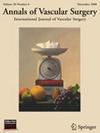Thirty-Day Outcomes of Infrainguinal Bypass Surgery in Patients With Disseminated Cancer
IF 1.6
4区 医学
Q3 PERIPHERAL VASCULAR DISEASE
引用次数: 0
Abstract
Background
Disseminated cancer can complicate the decision-making for major surgery, as patients can be poor surgical candidates and have potentially limited life expectancy. This study aimed to evaluate the 30-day postoperative outcomes of infrainguinal bypass in patients with disseminated cancer using a large-scale national database.
Methods
Adult patients with and without disseminated cancer who underwent infrainguinal bypass were identified in the American College of Surgeons National Surgical Quality Improvement Program database from 2011 to 2023. A 1:5 propensity-score matching was used to balance the preoperative factors. Thirty-day postoperative outcomes were compared. A separate multivariable analysis was also conducted.
Results
There were 25,200 patients who underwent infrainguinal bypass, where 120 (0.48%) patients had disseminated cancer, who were matched to 596 patients with no disseminated cancer. Patients with disseminated cancer had higher risks of mortality (13.33% vs. 6.21%, P = 0.01) and untreated loss of patency (5.83% vs. 1.34%, P = 0.01). Other 30-day outcomes, including major amputation (5.41% vs. 4.24%, P = 0.61), cardiac complications (4.17% vs. 5.54%, P = 0.66), stroke (0.83% vs. 0.84%, P = 1.00), pulmonary complications (2.50% vs. 6.71%, P = 0.09), and renal complications (0.83% vs. 2.35%, P = 0.49), were comparable between patients with and without disseminated cancer. Multivariable analysis confirmed higher mortality and untreated loss of patency among disseminated cancer patients, while deep vein thrombosis was also found to be higher in this group (4.17% vs. 0.96%, adjusted odds ratio 3.763, 95% confidence interval 1.507–9.399, P < 0.01).
Conclusion
Disseminated cancer patients demonstrated more than twice the 30-day mortality risk and over 4 times the risk of untreated loss of patency. As such, infrainguinal bypass should be considered a high-risk procedure for disseminated cancer patients, and the clinical decision for surgery should be made with caution. Deep vein thrombosis (DVT) was also found to be higher among disseminated cancer patients after multivariable analysis, suggesting DVT prophylaxis among these patients may need to be optimized. Future studies should focus on the long-term prognosis, particularly limb outcomes, in disseminated cancer patients.
弥散性癌症患者腹股沟下搭桥手术的30天预后。
背景:播散性癌症可能使大手术的决策复杂化,因为患者可能不适合手术,并且可能限制预期寿命。本研究旨在通过大规模的国家数据库评估弥散性癌症患者腹股沟下搭桥术后30天的预后。方法:2011-2023年,在ACS-NSQIP数据库中确定行腹股沟下旁路手术的成年伴或不伴弥散性癌症患者。采用1:5倾向性评分匹配来平衡术前因素。比较术后30天的结果。还进行了单独的多变量分析。结果:25200例患者行腹股沟下旁路手术,其中弥散性癌120例(0.48%),与无弥散性癌596例相匹配。弥散性肿瘤患者的死亡率较高(13.33% vs 6.21%, p=0.01),未治疗的通畅丧失风险较高(5.83% vs 1.34%, p=0.01)。其他30天的结果,包括主要截肢(5.41% vs 4.24%, p=0.61)、心脏并发症(4.17% vs 5.54%, p=0.66)、中风(0.83% vs 0.84%, p=1.00)、肺部并发症(2.50% vs 6.71%, p=0.09)和肾脏并发症(0.83% vs 2.35%, p=0.49),在有和没有弥散性癌症的患者之间具有可比性。多变量分析证实,弥散性肿瘤患者的死亡率和未经治疗的通畅性丧失更高,深静脉血栓形成也更高(4.17% vs 0.96%, aOR 3.763, 95 CI 1.507-9.399, p)结论:弥散性肿瘤患者30天死亡风险是未经治疗的通畅性丧失风险的两倍多,超过四倍。因此,对于弥散性肿瘤患者,腹股沟下旁路手术是一种高风险手术,临床应谨慎决定是否进行手术。多变量分析还发现,播散性癌症患者的DVT发生率更高,提示这些患者的DVT预防可能需要优化。未来的研究应关注播散性癌症患者的长期预后,特别是肢体预后。
本文章由计算机程序翻译,如有差异,请以英文原文为准。
求助全文
约1分钟内获得全文
求助全文
来源期刊
CiteScore
3.00
自引率
13.30%
发文量
603
审稿时长
50 days
期刊介绍:
Annals of Vascular Surgery, published eight times a year, invites original manuscripts reporting clinical and experimental work in vascular surgery for peer review. Articles may be submitted for the following sections of the journal:
Clinical Research (reports of clinical series, new drug or medical device trials)
Basic Science Research (new investigations, experimental work)
Case Reports (reports on a limited series of patients)
General Reviews (scholarly review of the existing literature on a relevant topic)
Developments in Endovascular and Endoscopic Surgery
Selected Techniques (technical maneuvers)
Historical Notes (interesting vignettes from the early days of vascular surgery)
Editorials/Correspondence

 求助内容:
求助内容: 应助结果提醒方式:
应助结果提醒方式:


